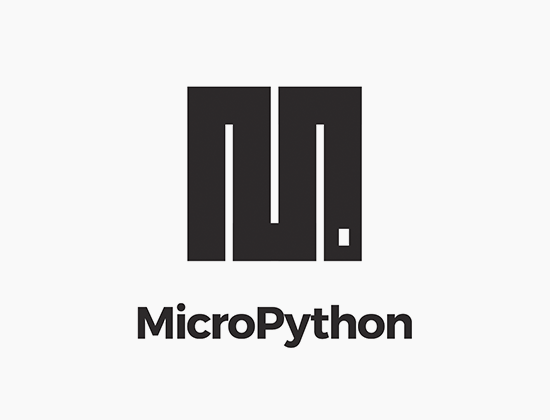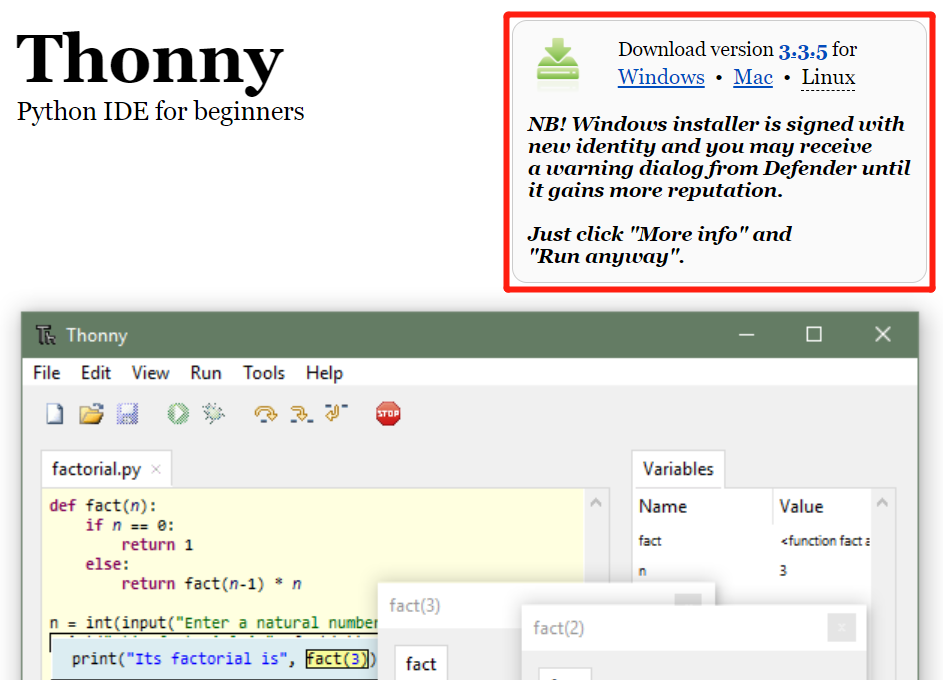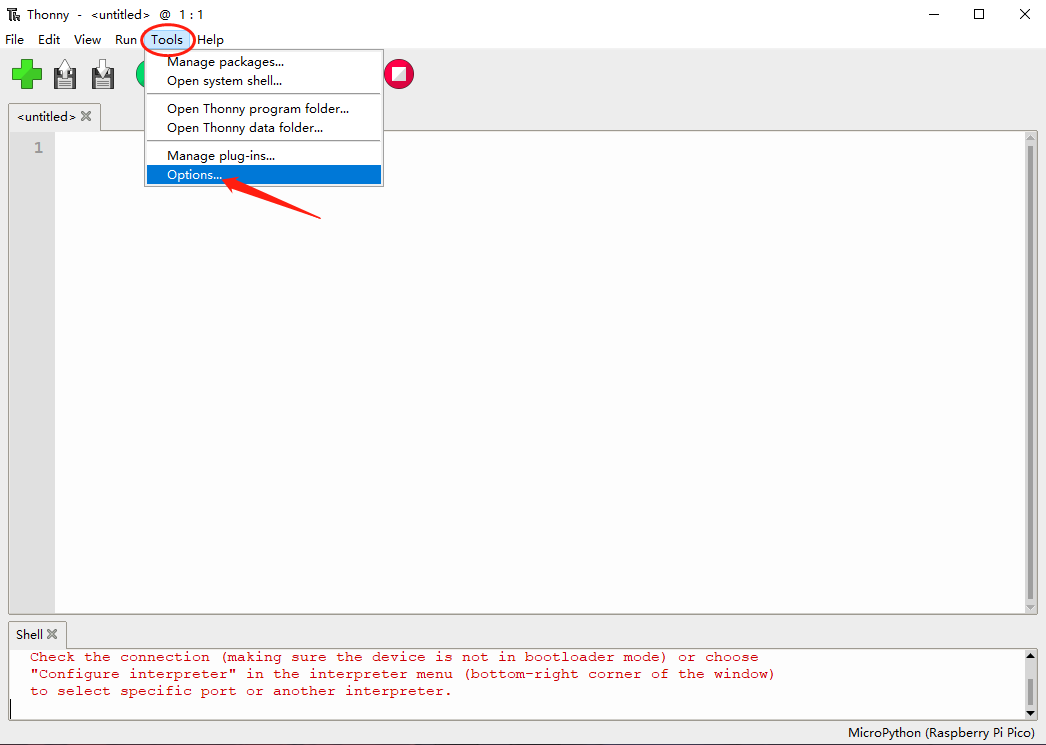| description | title | keywords | image | slug | last_update | |||||
|---|---|---|---|---|---|---|---|---|---|---|
Seeed Studio XIAO SAMD21 with MicroPython |
MicroPython |
|
/cn/XIAO-SAMD21-MicroPython |
|
MicroPython是一个具有部分本地代码编译功能的Python解释器。它提供了Python 3.5特性的一个子集,用于嵌入式处理器和受限系统。它与CPython不同,你可以在这里阅读更多的差异。
首先,我们将Seeed Studio XIAO SAMD21连接到计算机,并从MicroPython上传一个简单的代码来检查电路板是否正常运行。
- Seeed Studio XIAO SAMD21 x1
- Type-C 数据线 x1
- PC x1
- Step 1. 根据您的操作系统下载并安装最新版本的Thonny editor
-
Step 2.启动 Thonny
-
Step 3. 点击 "Tools-->Options" 来打开设置
- Step 4. 选择“interpreter”接口并选择设备为**“MicroPython(通用)”将端口设置为“Try to detect prot automatically”**
- Step 1. 按住“BOOT”按钮,然后通过Type-C电缆将Seeed Studio XIAO SAMD21连接到PC。如果运行良好,电脑上会显示一个“Arduino”
- Step 2. Flash the firmware(闪存固件)
对于windows:
复制Seeed XIAO SAMD21 firmware for MicroPython Support并将其放在此文件夹中
对于Linux:
wget "https://micropython.org/resources/firmware/SEEED_XIAO-20220618-v1.19.1.uf2"
cp SEEED_XIAO-20220618-v1.19.1.uf2 /media/$USER/Arduino/也可以编译自己的固件,以确保安全性和支持最新的功能,但这不是必要的。
| Pin | GPIO | Xiao Pin name | IRQ | ADC |
|---|---|---|---|---|
| 2 | PA02 | 0 | 2 | 0 |
| 4 | PA04 | 1 | 4 | 4 |
| 10 | PA10 | 2 | 10 | 18 |
| 11 | PA11 | 3 | 11 | 19 |
| 8 | PA08 | 4 | * | 16 |
| 9 | PA09 | 5 | 9 | 17 |
| 40 | PB082 | 6 | 8 | 2 |
| 41 | PB09 | 7 | 9 | 3 |
| 7 | PA07 | 8 | 7 | 7 |
| 5 | PA05 | 9 | 5 | 5 |
| 6 | PA06 | 10 | 6 | 6 |
| 18 | PA18 | RX_LED | 2 | * |
| 30 | PA30 | SWCLK | 10 | * |
| 31 | PA31 | SWDIO | 11 | * |
| 19 | PA19 | TX_LED | 3 | * |
点击“Run current script”按钮上传代码。第一次,托尼会问你想在哪里保存你的代码文件。这台计算机和MicroPython设备都没问题。
如果想离线使用该程序,应该将该程序保存到XIAO SAMD21
同时按住Ctrl + Shift + S,然后选择save to MicroPython device
我们需要准备:
将以下代码复制给Thonny。
我们可以看到蓝色的RX_LED被点亮并每秒闪烁一次
from machine import Pin, Timer
led = Pin(18, Pin.OUT)
Counter = 0
Fun_Num = 0
def fun(tim):
global Counter
Counter = Counter + 1
print(Counter)
led.value(Counter%2)
tim = Timer(-1)
tim.init(period=500, mode=Timer.PERIODIC, callback=fun)我们需要准备:
from machine import Pin, Timer
output_4 = Pin(8, Pin.OUT)
detect_1 = Pin(4, Pin.IN, Pin.PULL_UP)
output_value = Pin(2, Pin.OUT)
Counter = 0
def fun(tim):
global Counter
Counter = Counter + 1
output_4.value(Counter%2)
print(Counter%2,detect_1.value())
if detect_1.value() :
output_value.value(1)
else:
output_value.value(0)
tim = Timer(-1)
tim.init(period=200, mode=Timer.PERIODIC, callback=fun)我们需要准备:
- Doppler radar for human detection(多普勒人体探测雷达)
- Seeeduino-XIAO-Expansion-Board
- Grove-Relay
- Seeed Studio XIAO SAMD21
from machine import Pin, Timer
led = Pin(8, Pin.OUT)
input_value_1 = Pin(4, Pin.IN, Pin.PULL_UP)
input_value_2 = Pin(10, Pin.IN, Pin.PULL_UP)
output_value = Pin(2, Pin.OUT)
Counter = 0
Fun_Num = 0
def fun(tim):
global Counter
Counter = Counter + 1
led.value(Counter%2)
print(input_value_1.value(),input_value_2.value())
if input_value_1.value() :
output_value.value(1)
else:
output_value.value(0)
tim = Timer(-1)
tim.init(period=50, mode=Timer.PERIODIC, callback=fun)from machine import Pin, SoftI2C
i2c = SoftI2C(scl=Pin(9), sda=Pin(8), freq=100000)
devices = i2c.scan()
for device in devices:
print("Decimal address: ",device," | Hexa address: ",hex(device))
i2c.writeto(0x51, 'b')
print(i2c.readfrom(0x51, 4)) # read 4 bytes from device with address 0x51
i2c.writeto(0x51, 'a') # write 'a' to device with address 0x51
print(i2c.readfrom(0x51, 4)) # read 4 bytes from device with address 0x51
i2c.writeto(0x51, 'b')
print(i2c.readfrom(0x51, 4)) 熟悉micropython可以让您做更多,我们期待为您创造更多价值。也欢迎和我们分享你的项目!
我们的合作伙伴Neil使用MicroPython为XIAO编写了一个命令行控制台程序。有了这个程序,你可以轻松上传,下载和删除文件。我们感谢他对XIAO的贡献!
感谢您选择我们的产品!我们在这里为您提供不同的支持,以确保您使用我们的产品的体验尽可能顺利。我们提供多种沟通渠道,以满足不同的喜好和需求。







